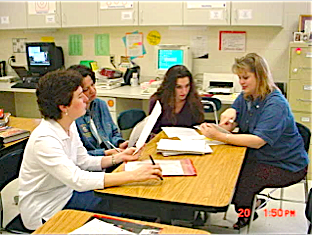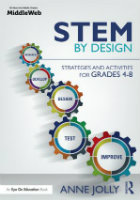How to Write Your Own STEM Elevator Speech
A MiddleWeb Blog
 I did a double take when this message rolled across a national science teachers’ discussion group I watch.
I did a double take when this message rolled across a national science teachers’ discussion group I watch.
If you’re a STEM teacher – and possibly a science teacher who integrates STEM projects into science classes – you might relate. (I am passing this along with the author’s permission.)
My principal recently stated that we are no longer doing “dissections and labs or things like that” because “the whole country is moving toward STEM.” His understanding of STEM is that it involves “robotics and other technology.”
He plans to have expensive new “virtual reality labs” installed in all of the science rooms. He had the company come in to give us a demo of this new VR system. It involves putting on a visor that allows the wearer to see a virtual lab room and hold a wand to manipulate virtual tools and lab equipment.
My comment was that our students need real experiences with real things, not more video games, and that this money could be put to better use upgrading our science rooms (which are relics from the 50s). This didn’t go over too well. We are not getting new lab supplies because we are now supposed to be “doing STEM” instead.
I tried to explain that STEM means the integration of the four areas; not the replacement of traditional science labs, but the inclusion of technology and engineering design challenges in inquiry-based labs. Also, my state’s department of education mandates that labs are to be included in all lab sciences. My principal does not consider the opinions of a teacher to be valid, so I need some resources to back up my statements.
I shuddered when I read that message. How many of us who are teachers and former teachers have worked hard to implement high-quality learning for our kids only to be undercut by a poorly informed administrator and/or a lack of needed resources?
Two familiar problems contributing to this teacher’s situation jumped out at me.
1. The person making the decisions knows next to nothing about STEM (or science, apparently), yet decides how STEM education will be incorporated into the curriculum.
I don’t know why this technology was believed to substitute for an integrated STEM program, but watch out! Some “STEM” suppliers are skilled at selling things that don’t actually accomplish the purposes of STEM. And some hard-pressed administrators are vulnerable to claims that the “new thing” will save money in the long run.
To make strategic STEM decisions, the decision makers must begin with a clear, informed understanding of STEM.
2. The teacher’s knowledge and expertise are not valued. (Deep breath.) I’ll try to restrain myself on this topic – dear to my heart – and save it for another post. But I’ll certainly point out that teachers must be included and valued in decision-making, especially when it involves teaching and learning.
Administrators and policy makers must respect teachers as education partners and call on their knowledge and experience. That’s a no-brainer. After all, teachers are the people closest to the students – the ones who make teaching and learning happen. They are also the educators most likely to be keeping up with state requirements, content standards, and advances in their field.
Note to administrators: Here’s a time-tested recipe for the improving teaching and learning in your school: Honor what teachers know. Listen to what teachers say. Effective leaders aren’t threatened by informed advice.
What’s next?
The message I shared from my PLN group flags an important need, in my opinion – a need for stakeholders (teachers, principals, parents, community people, business partners, etc.) to gain a richer, more educated understanding of STEM education.
Here’s an opportunity for STEM teachers to become leaders in their schools and communities. As a teacher who studies, plans, guides, evaluates, and re-designs STEM lessons, you are building a strong knowledge base about STEM teaching and learning.

You also need some talking points to explain the “what” of STEM – what an integrated STEM program typically includes. In fact, you probably also need a brief explanation of what is NOT STEM.
Sound like more than two minutes? Not if you craft and polish your core message in advance. Put it on an index card. Or your phone! Here are a few talking points you can use. Adjust to match your needs and style.
Talking Points: Why teach STEM?
When our kids graduate, most of the available jobs will be linked to careers focused on science, technology, engineering and math. Business and industry are already asking us to send them capable workers with cutting-edge technology skills and a much deeper mastery of science and mathematics.
Employers want employees who can identify and solve problems, think creatively and work successfully on teams. The students we send them must be able to tackle pressing challenges like climate change, food shortages, energy shortages, a sustainable environment, rapid increases in diseases, and a growing clean water problem, to name just a few.
Teachers are the key players in producing that talent pool. Sure – we are turning out students who do well in math and science in the classroom, but that doesn’t necessarily equip them with the workforce skills they need. That’s where STEM comes in.
A strong STEM education gives students an opportunity to apply science and math to real-world scenarios. They learn to work together, develop new approaches, and solve real problems. And all students benefit from STEM lessons. Educating students in STEM (if taught correctly) prepares them for life, regardless of the profession they choose to follow.
Get more information on this topic here: 7 Solid Reasons to Involve Students in STEM.
Talking Points: What does STEM education look like?
STEM is not a subject. STEM is a way of teaching that helps prepare your students for learning and working in the real world where they will spend the rest of their lives. In STEM classrooms teachers act as facilitators, and kids take charge of their own learning. They work together in teams, they inquire, they create solutions for open-ended problems. They research and plan; design and construct prototypes that offer ways to address real-world needs.

Get more information on this topic: The 8 Criteria for Authentic STEM Programs.
Talking Points: What is NOT STEM education?
STEM is not a single subject. It’s not just science, not just math, and not just technology. STEM is a purposeful blend of these subjects that helps kids apply grade level content to engineer solutions for real problems. It’s not a new word for science class.
STEM is not an all-inclusive interdisciplinary initiative. STEM is a way of teaching that maintains an intense focus on integrating science, math, and technology through engineering. While project-based learning may be a good fit for teaching STEM, simply offering a PBL program in a school does not mean that school is automatically teaching STEM.
One more thing . . .
Not all science and math teachers welcome the idea of integrating their content areas. Some dismiss STEM as a fad rather than as a way of connecting learning to how the actual world works outside of their classroom. They want to teach same way that they’ve been doing for their entire teaching career.
But you – a well-informed STEM teacher – can be a great resource to help colleagues become more knowledgeable about STEM and more willing to adopt an effective way of preparing kids for the real world. Go for it!
_________________________________________






























